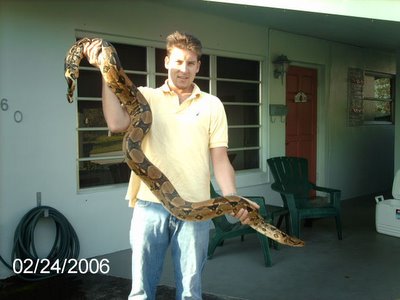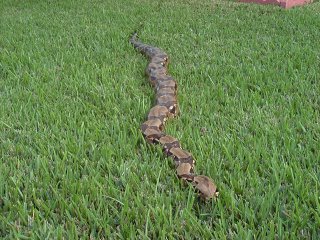
Boa Constrictor Found in Florida Everglades
This Boa sighting and capture in the Florida Everglades was amazing. At almost 9 ft long she was a handful. I am lucky she did not wrap one of those muscular coils around me; sending me to bed . These snakes are native to South and Central America (indicated by the green below) and are an exotic species here in Florida. 
I have always loved Boa constrictors, and even had a few individuals as an adolescent. Although, this is not the first time I have caught them in the wilds of sunny South Florida. The first time I was merely 13 years old and my friends and I came across 6 - 8 very small individuals lying in some grasses along a canal in Davie, Fl. At that time we assumed that the snakes were released by some irresponsible care-taker. But as I look back on that scenario, I can now envision the mother of those snakes not far off the side of the road sitting still in a nearby Australian Pine, which I would like to add is also an invasive species here in Florida, waiting in complete stillness for an unknowing song bird to come within striking distance.
It is hard to fathom a sighting of a Boa Constrictor in the Everglades, perhaps I thought I would see a Burmese python or Reticulated python due to the fact that sightings have already been confirmed. I am asked very frequently if I come across many Burmese pythons as I survey the Everglades tree islands in Water conservation areas 3A and 3B in Broward, Dade, and Monroe counties. I suppose people think their are very large numbers of pythons out in the glades, because that is what makes the news. I have been on many Tree islands and this is the first time I have seen a large constrictor or rather any constrictors, besides the 6 foot Yellow Rat snake I came across a couple of months ago.

Needless to say, it is definitely a problem. This particular individual was so large and fat that I suspect it had been eating very well. The numbers of native water fowl and song birds it had eaten since the time of its release is most likely very high. This is a serious problem for the ecology of the Everglades. There are no natural enemies to these invasive exotic snakes and therefore a quite detrimental situation arises. Thanks to my co-worker and friend Craig we were able to remove it from the Glades where it had no business being; even though it looked so content sitting there on its own private island.
Be careful she bites. I guess if someone took me away from my personal heaven, full of all the food I could eat, all the sun I could soak up, and all the water I could drink I would be mad too.
No hard feelings!

Check out more about Boa Constrictors at www.boa-constrictors.com




